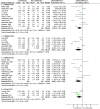Cryotherapy for Rehabilitation After Total Knee Arthroplasty: A Comprehensive Systematic Review and Meta-Analysis
- PMID: 39402654
- PMCID: PMC11608804
- DOI: 10.1111/os.14266
Cryotherapy for Rehabilitation After Total Knee Arthroplasty: A Comprehensive Systematic Review and Meta-Analysis
Abstract
Objective: Despite being well-studied and widely utilized, the efficacy of cryotherapy after total knee arthroplasty (TKA) in enhancing early rehabilitation lacks consensus. The aim of this systematic review and meta-analysis was to investigate (1) whether cryotherapy is able to promote the rehabilitation of patients undergoing TKA and (2) whether continuous cold flow device has superior results than cold pack in cryotherapy.
Methods: A comprehensive trial searching was performed in the PubMed, Embase, Cochrane Library, and Google Scholar electronic databases in May, 2024. Randomized controlled trials (RCTs) comparing cryotherapy with no cryotherapy or comparing continuous cold flow device with cold pack after TKA were included. The primary outcome was visual analogue scale (VAS) of pain, and secondary outcomes included opioid consumption, blood loss (hemoglobin decrease and drainage), range of motion (ROM), swelling, length of stay (LOS), and adverse event.
Results: A total of 31 RCTs were included in this meta-analysis with 18 trials comparing cryotherapy with no cryotherapy and 13 trials comparing continuous cold flow device with cold pack. Pooled results showed cryotherapy group had significantly lower VAS scores than no cryotherapy group on postoperative day (POD) 1 (MD, -0.59 [95% CI, -1.14 to -0.04]; p = 0.04), POD 2 (MD, -0.84 [95% CI, -1.65 to -0.03]; p = 0.04), and POD 3 (MD, -0.86 [95% CI, -1.65 to -0.07]; p = 0.03). Cryotherapy group also showed reduced opioid consumption, reduced hemoglobin loss, decreased drainage, and improved ROM after TKA. Continuous cold flow device group had comparable VAS, opioid consumption, blood loss, ROM, knee swelling, and LOS with cold pack group.
Conclusion: Cryotherapy can effectively alleviate postoperative pain, reduce blood loss, improve ROM, and thus promote the postoperative rehabilitation for TKA patients, but the continuous cold flow device did not show better efficacy than cold packs. These findings support the routine use of cryotherapy for the rapid rehabilitation of TKA patients, and the traditional cold pack is still recommended.
Keywords: cryotherapy; systematic review and meta‐analysis; total knee arthroplasty.
© 2024 The Author(s). Orthopaedic Surgery published by Tianjin Hospital and John Wiley & Sons Australia, Ltd.
Conflict of interest statement
The authors declare no conflicts of interest.
Figures
References
-
- Ding Z., Li J., Xu B., Cao J., Li H., and Zhou Z., “Preoperative High Sleep Quality Predicts Further Decrease in Length of Stay After Total Joint Arthroplasty Under Enhanced Recovery Short‐Stay Program: Experience in 604 Patients From a Single Team,” Orthopaedic Surgery 14, no. 9 (2022): 1989–1997. - PMC - PubMed
-
- Mistry J. B., Elmallah R. D., Bhave A., et al., “Rehabilitative Guidelines After Total Knee Arthroplasty: A Review,” Journal of Knee Surgery 29, no. 3 (2016): 201–217. - PubMed
-
- Chughtai M., Sodhi N., Jawad M., et al., “Cryotherapy Treatment After Unicompartmental and Total Knee Arthroplasty: A Review,” Journal of Arthroplasty 32, no. 12 (2017): 3822–3832. - PubMed
Publication types
MeSH terms
Grants and funding
LinkOut - more resources
Full Text Sources
Medical






